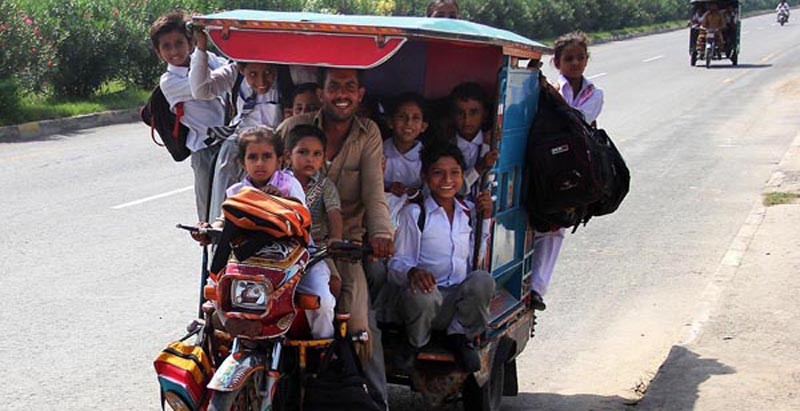
Several steps are urgently required to improve the rickety school transport system

No one can empathise with the parents whose beloved children perished when their school van overturned in Narowal on March 19, 2015. And this is not an isolated accident. Not long ago, the Daulatpur-Nawabshah mishap left the whole nation deeply grieved the previous year. 18 schoolchildren and three teachers died with many more in critical conditions. Heart wrenching scenes were witnessed outside hospitals and at the residences of victims. But this was not an isolated incident.
Trail of accidents involving school transport is an ongoing issue hitherto unaddressed. Fitness and road worthiness of school transport is a nationwide predicament. Urban regions of Karachi, Lahore, Rawalpindi and other urban agglomerations present a gloomy picture.
Early morning or mid-afternoon images of rickety, noisy and overloaded vans of ancient types and prototypes carrying schoolchildren with sweaty faces are most tormenting. In the sizzling summers, these over-packed vehicles can be commonly spotted moving on various Karachi streets. Many city areas, where schools have mushroomed without any planning foresight, become completely clogged during the morning and afternoon timings. Operations and performance of this service is anything but satisfactory.
Leading stakeholders in this affair are the transport contractors. They exist in different scales, ranks and profile. Due to long distances between schools and residences of pupils, transporters have to juggle around route organisation to make the service efficient. As a norm, the children who reside faraway from the school have to suffer intensely. They are picked up earliest in the morning and dropped in the last. Prices of fuel have risen exponentially during the past few years. During the previous regimes, diesel prices were not affected, as it was consumed for public transportation of various kinds. In many cases the whole service becomes loss-oriented as the bus fee is not raised before academic session.
However, most of the transporters are found using CNG (compressed natural gas) cylinders which have leaking connections. While the use of non-certified CNG cylinders in vehicles is officially prohibited, it becomes critically hazardous for children. Such cylinders are prone to explosion and fire due to lack of any kind of safety installations. Poor condition of roads adversely affect the shock absorbers and seating in vehicles. At times the children are completely exhausted after these tiresome journeys.
Fleecing is routinely reported by carriers. According to these operators, the system of coercion has now become a meticulously organised enterprise. In case of argument by the driver, heavy penalties are imposed on them by traffic wardens. Since drivers have to meet the school timings, they do not usually engage into debates and attempt to settle the matter amicably. Under contractual arrangements, where school management hires bus contractors, the ordeal for transporters is severe.
School management fleeces parents by charging high fees but seldom shares any portion of it with transporters. In some cases, management also charges registration fee from transporters on a unit vehicle basis. At times, these vehicles are found injecting tonnes of black exhausts into the air due to rundown engines and poor quality lubricants. Maintenance and repair is only done on a fire fighting basis. School buses, with very few exceptions, are very old. Due to unavailability of credit from formal banking channels, transporters cannot obtain funds to replenish their fleet. It leads to poor quality of services.
Operators of schools, especially in the private sector, are a key player in this situation. However, they happen to be unconcerned about the problems of school transport. Few schools did take the initiative of pre-qualifying the transport contractors and assessing the quality of their fleet. The number of such instances was very limited. Since private schools had no commercial interest in this whole enterprise, they did not bother to exercise control on the routine working of school transport system.
Traffic police officials, sounding articulate, threw the entire blame on transporters. They accused transporters on several counts. Under-qualified drivers lacking basic skills and driving license; declining fitness of vehicles; overloading; incomplete documents of vehicles and overspeeding were a few common observations cited by traffic police personnel. Some of these shortcomings were a routine cause of accidents.
Several steps are urgently required to improve the scenario. One, the school enrolment has to be encouraged according to locality/neighbourhood basis. If opportunities of quality education are provided along all the spread out localities, the tendency to send children to far away places shall decline. It must be understood that this change can occur through incentives only.
Private sector school operators can be encouraged through incentives and subsidies to open quality learning institutions in lower middle and middle income areas.
Two, the school transport sector must be regulated after a fair assessment of their problems. The school transporters should be provided with access to formal credit for improving their fleet of buses. Some kind of assistance may also be extended to rationalise their operational costs.
And three, a monitoring mechanism is vital to be instituted in order to check the performance of transporters. A joint monitoring body of all stakeholders may be constituted with the police department playing the role of facilitator. The latest components in information technology may be used to undertake this task.
Vehicle monitoring devices, which are common place in tracking the movement of automobiles, may be installed in school buses to observe their movement. The Pakistan Sustainable Transport Project has begun reviewing this issue and also conducted a series of activities for capacity building of various stakeholders during the recent past. The scope and scale of this initiative must take into account the various challenges discussed above to formulate realistic policies and programmes.